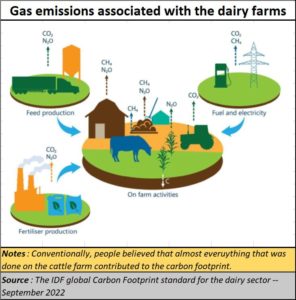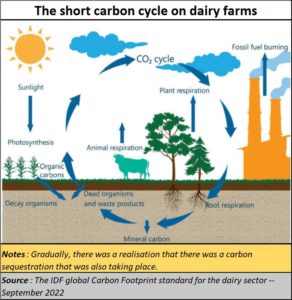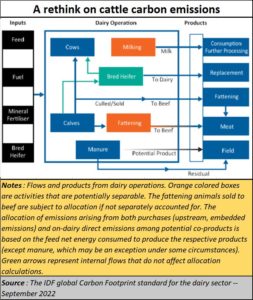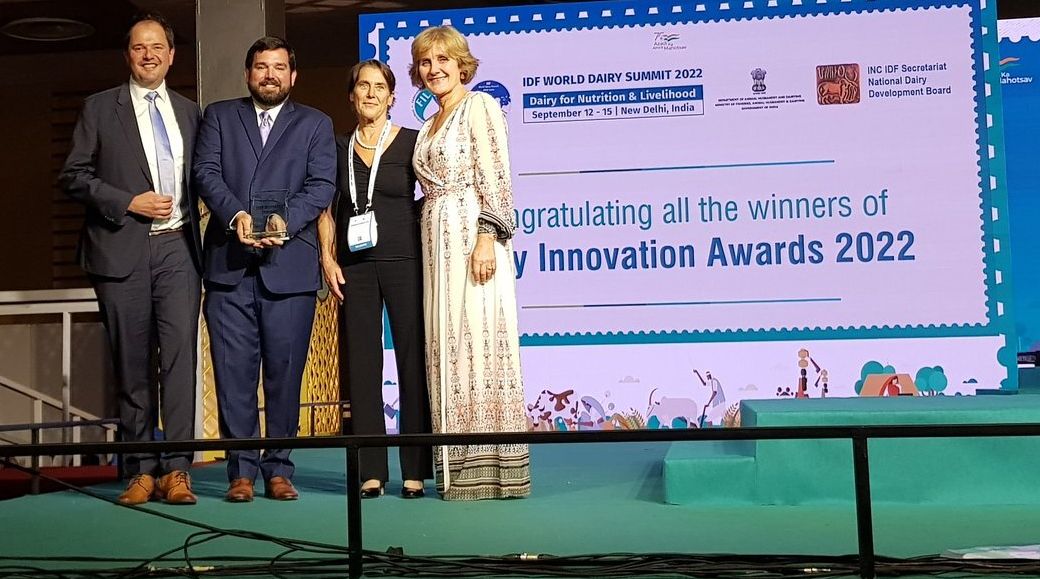https://www.freepressjournal.in/analysis/a-reassessment-of-the-carbon-footprint-from-cattle-2
A reassessment of the carbon footprint from cattle
RN Bhaskar
An extremely important Bulletin was released by the International Dairy Federation in Delhi During the World Dairy Day proceedings (Sept 12-15, 2022). It was titled “The IDF Global  Carbon Footprint Standard for the Dairy Sector” (https://fil-idf.org/news_insights/a-new-bulletin-with-a-revised-idf-global-carbon-footprint-methodology-for-the-dairy-industry-was-published-today/) .
Carbon Footprint Standard for the Dairy Sector” (https://fil-idf.org/news_insights/a-new-bulletin-with-a-revised-idf-global-carbon-footprint-methodology-for-the-dairy-industry-was-published-today/) .
Its very first paragraph of its Foreword states “We are proud to present this edition dedicated to the Life Cycle Assessment (LCA) Methodology: IDF’s global standard for assessing carbon footprint in the dairy sector. It is worth noting that it is the only global dairy standard to measure carbon footprint. The adage says, ‘We can’t reduce what we can’t measure’.”
The foreword goes on to add that the “The first LCA methodology for the dairy sector was developed and published in 2010 by the IDF Standing Committee on Environment (SCENV) with active participation of the Food and Agriculture Organization of the United Nations (FAO) and the Sustainable Agriculture Initiative Platform (SAI Platform). . . . . .it was continuously reviewed and revised by our experts to reflect evolving science. Consequently, updated versions of the bulletin were published in 2015 and in 2020.”
 The LCA is a boon for countries involved with the diary sector – especially India – because the world kept telling them that they were producers of methane caused by the burbs and the farts of cattle. The dung also created methane. India was the most disadvantaged because it has the largest number of cattle (India has both cows and buffaloes. Most Western countries, including New Zealand, do not have buffaloes).
The LCA is a boon for countries involved with the diary sector – especially India – because the world kept telling them that they were producers of methane caused by the burbs and the farts of cattle. The dung also created methane. India was the most disadvantaged because it has the largest number of cattle (India has both cows and buffaloes. Most Western countries, including New Zealand, do not have buffaloes).
India was actually being cornered during almost all discussions involving climate change, urging it to review its commitment to the dairy sector in order to reduce the carbon footprint. One of the biggest attacks was on India’s promotion of the cattle industry. After all, in 2019, according to the government, India had (https://pib.gov.in/PressReleasePage.aspx?PRID=1588304) “a total Livestock population is 535.78 million showing an increase of 4.6% over Livestock Census-2012”,
Compare this to the approximately 1.48. billion cattle that were reared worldwide the same year, according to the Food and Agriculture Organization (FAO) of the United Nations (2019). India thus accounted for almost half the cattle population globally (https://ourworldindata.org/grapher/cattle-livestock-count-heads). This is because, unlike many other countries, India believes not in mass production, but in production by the masses. Most Indian farmers have just one or two cows in their backyard.
 Of course, there are reasons to believe that many developed countries were also not happy with India’s growing clout in the diary industry. It had already become the world’s largest milk producer, thanks to the vision of Verghese Kurien (https://asiaconverge.com/2021/11/remembering-kurien-and-how-much-the-country-owes-to-him/ ). Global players also began attacking India for its slow progress on dealing with the Foot and Mouth Disease (FMD) Many nations keen on allowing India’s dairy exports into their own territories wanted to first see all cattle in India vaccinated against FMD. The government has begun working on this on a war footing (https://dahd.nic.in/sites/default/filess/FMD%20RFP.pdf).
Of course, there are reasons to believe that many developed countries were also not happy with India’s growing clout in the diary industry. It had already become the world’s largest milk producer, thanks to the vision of Verghese Kurien (https://asiaconverge.com/2021/11/remembering-kurien-and-how-much-the-country-owes-to-him/ ). Global players also began attacking India for its slow progress on dealing with the Foot and Mouth Disease (FMD) Many nations keen on allowing India’s dairy exports into their own territories wanted to first see all cattle in India vaccinated against FMD. The government has begun working on this on a war footing (https://dahd.nic.in/sites/default/filess/FMD%20RFP.pdf).
According to knowledgeable sources, India should be in a position of having vaccinated all its cattle for the FMD within a next few years. This country should then be in a position to take up dairy exports even more aggressively. Another disease that is being taken seriously is the lumpy skin disease against which too, all cattle in India are being vaccinated (https://www.hindustantimes.com/cities/pune-news/all-cattle-to-be-vaccinated-to-curb-lumpy-skin-disease-vikhepatil-101663341240141.html).
That is why India began working on ways to lobby against this unfair criticism of developed countries against India’s dairy sector. It must have asked the International Dairy Federation to intervene and provide the world with the right perspective. The IDF finally decided to host its world dairy day conference in India after a span of almost 48 years (https://asiaconverge.com/2022/09/world-dairy-summit-forgets-verghese-kurien/). The release of the Bulletin referred to above thus becomes a major step in educating the world about the need to look at the diary industry differently because the measuring tools used were wrong. More on this will be dealt with in a subsequent article.
 And that is where the modified approach to the carbon footprint from dairy farms comes in. IDF has begun educating the world that the tools it has been using for this crucial sector were not the right ones. It pointed out that the dairy industry also reduces the carbon footprint in many ways. The chart now considers the way the cattle urine and dung actually fertilises the soil and allows the earth the easy respiration it requires. It talks about the food the cattle provides by way of beef and milk which adds to the nutrition of human beings. Much of this nutrition would have to be grown in other ways, which in turn would have created a larger carbon footprint than might appear at first sight. All of a sudden, the cattle becomes part of the virtuous cycle in nature, and the new way of calculating the carbon footprint from dairy farms is quite refreshing and even sensible.
And that is where the modified approach to the carbon footprint from dairy farms comes in. IDF has begun educating the world that the tools it has been using for this crucial sector were not the right ones. It pointed out that the dairy industry also reduces the carbon footprint in many ways. The chart now considers the way the cattle urine and dung actually fertilises the soil and allows the earth the easy respiration it requires. It talks about the food the cattle provides by way of beef and milk which adds to the nutrition of human beings. Much of this nutrition would have to be grown in other ways, which in turn would have created a larger carbon footprint than might appear at first sight. All of a sudden, the cattle becomes part of the virtuous cycle in nature, and the new way of calculating the carbon footprint from dairy farms is quite refreshing and even sensible.
For India, the benefits will be greater, and this will be dealt with n a later article. But it should be sufficient to say at this stage that the focus is now shifting to other aspects of the dairy industry. The attention is now on milk, beef, the nutrition they provide to the world, and to the replacement of hydrocarbon-based fertilisers to organic fertilisers. Efforts by many countries, particularly India, in harnessing the dung for energy as electricity, or CNG for home cooking purposes or for energising vehicles has now begun being talked about.
 The more one looks at these sectors, as ways in which carbon emissions are actually being offset, the India picture is not as dismal as the one the world was trying to paint all along.
The more one looks at these sectors, as ways in which carbon emissions are actually being offset, the India picture is not as dismal as the one the world was trying to paint all along.
Organisations like the National Dairy Development Board (NDDB) – another organisation created by Kurien and the then prime minister Lal Bahadur Shastri – will become extremely relevant in educating the world about how to measure carbon footprints in a country like India. These studies will also be used to education Indian farmers on how to ensure that the carbon footprint rom its cattle do not harm the environment.
With these measurement tools from the IDF, the studies that NDDB is doing, and the FMD vaccines that are being implemented at a rapid pace, India should have many more interesting stories about its dairy industry that has made this country proud. It is worth reiterating that the Indian dairy sector is more than the output of rice and wheat put together. It accounts for almost a quarter of all agricultural GDP. Thus, accounting for almost 4-5% of national GDP. More important, it is the shortest and the most effective way of empowering farmers with purchasing power and rural incomes.
The IDF Bulletin will thus be a landmark development for this sector.





































COMMENTS